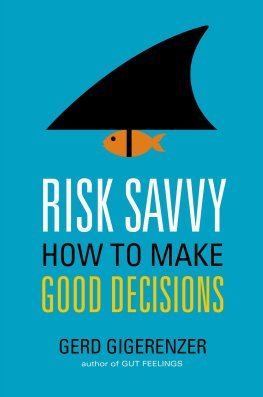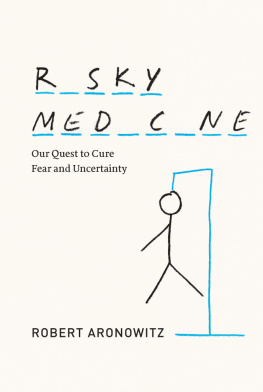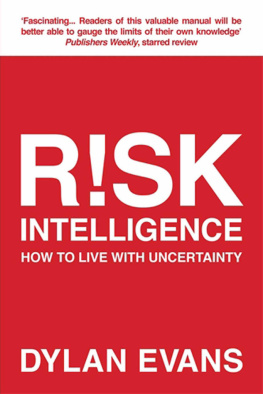Thank you for downloading this Simon & Schuster eBook.
Join our mailing list and get updates on new releases, deals, bonus content and other great books from and Simon & Schuster.
C LICK H ERE T O S IGN U P
or visit us online to sign up at
eBookNews.SimonandSchuster.com
We hope you enjoyed reading this Simon & Schuster eBook.
Join our mailing list and get updates on new releases, deals, bonus content and other great books from Simon & Schuster.
C LICK H ERE T O S IGN U P
or visit us online to sign up at
eBookNews.SimonandSchuster.com
SIMON & SCHUSTER
Rockefeller Center
1230 Avenue of the Americas
New York, NY 10020
www.SimonandSchuster.com
Copyright 2002 by Gerd Gigerenzer
All rights reserved,
including the right of reproduction
in whole of in part in any form.
SIMON & SCHUSTER and colophon are trademarks of Macmillan Library Research USA, license by Simon & Schuster, the publisher of this work.
Designed by Lisa Chovnick
Library of Congress Cataloging-In-Publication Data
Gigerenzer, Gerd.
Calculated risks : how to know when numbers deceive you / Gerd Gigerenzer.
p. cm.
Includes bibliographical references and index.
1. ProbabilitiesPopular works. 2. Mathematical statisticsPopular works. 3. UncertaintyPopular works I. Title.
QA273.15.G54 2002
519.2dc21 2002017010
978-0-7432-5423-6
For information regarding the special discounts for bulk purchases, please contact Simon & Schuster Special Sales at 1-800-456-6798 or
For my mother
ACKNOWLEDGMENTS
Books, like human beings, have a history. They are conceived in love and written with perspiration. My fondness for the topic of uncertainty and risk was inspired by Ian Hackings and Lorraine Dastons writings on the ideas of chance, rationality, and statistical thinking. David M. Eddys work on medical diagnosis, and that of Lola L. Lopes on decision making and risk, have shown me how these ideas flourish and shape our present world. My interest in the way medical and legal experts think, and how one can offer them mind tools to better understand uncertainties, started with Ulrich Hoffrage, once my student and now my colleague and friend, whom I heartily thank for the fun of some ten years of joint research. This work has continued with Ralph Hertwig, Stephan Krauss, Steffi Kurzenhuser, Sam Lindsey, Laura Martignon, and Peter Sedlmeier, as well as with other researchers at the Max Planck Institute for Human Development. Among the many people outside my research group who have shaped my thinking on the ideas presented in this book, I would like to thank Jonathan J. Koehler and John Monahan.
Many dear friends and colleagues have read, commented on, and helped shape the many versions of this book manuscript: Michael Birnbaum, Valerie M. Chase, Kurt Danziger, Norbert Donner-Banzhoff, George Daston, Robert M. Hamm, Ulrich Hoffrage, Max Houck, Gnther Jonitz, Gary Klein, Jonathan J. Koehler, Hans-Joachim Koubenec, Steffi Kurzenhuser, Lola L. Lopes, John Monahan, Ingrid Mhlhauser, Marianne Mller-Brettl, R. D. Nelson, Mike Redmayne, Joan Richards, Paul Slovic, Oliver Vitouch, William Zangwill, and Maria Zumbeel.
My special thanks go to Christine and Andy Thomson, one a lawyer and the other a psychiatrist, to whom I owe several of the case studies reported in this book.
Valerie M. Chase has edited the entire book manuscript and much clarity is due to her insight. Donna Alexander helped me at all stages of the development of the book, including the footnotes and references; she was a wonderful and critical support. Hannes Gerhardt joined in the final stages, Wiebke Moller helped find literature, even in the most remote places and Dagmar Fecht cleared the decks, making writing even possible.
Lorraine Daston, my beloved wife, gave me emotional and intellectual support during the four years I was gestating this book, and my daughter Thalia, always delightful and helpful, gave me valuable suggestions on improving the readability of the text.
People are important, but so is the environment in which one works. I have had the good fortune in the past few years to profit from the splendid intellectual atmosphere and the resources of the Max Planck Society, for which I am thankful.
CONTENTS
PART I
DARE TO KNOW
... in this world there is nothing certain but death and taxes.
Benjamin Franklin
1
UNCERTAINTY
Susans Nightmare
During a routine medical visit at a Virginia hospital in the mid-1990s, Susan, a 26-year-old single mother, was screened for HIV. She used illicit drugs, but not intravenously, and she did not consider herself at risk of having the virus. But a few weeks later the test came back positivewhich at the time amounted to a terminal diagnosis. The news left Susan shocked and distraught. Word of her diagnosis spread, her colleagues refused to touch her phone for fear of contagion, and Susan eventually lost her job. Finally, she moved into a halfway house for HIV-infected patients. While there, she had unprotected sex with another resident, thinking, Why take precautions if the virus is already inside of you? Out of concern for her 7-year-old sons health, Susan decided to stop kissing him and began to worry about handling his food. The physical distance she kept from him, intended to be protective, caused her intense emotional suffering. Months later, she developed bronchitis, and the physician who treated her for it asked her to have her blood retested for HIV. Whats the point? she thought.
The test came back negative. Susans original blood sample was then retested and also showed a negative result. What had happened? At the time the data were entered into a computer in the Virginia hospital, Susans original blood test result seems to have been inadvertently exchanged with those of a patient who was HIV positive. The error not only gave Susan false despair, but it gave the other patient false hope.
The fact that an HIV test could give a false positive result was news to Susan. At no point did a health care provider inform her that laboratories, which run two tests for HIV (the ELISA and Western blot) on each blood sample, occasionally make mistakes. Instead, she was told repeatedly that HIV test results are absolutely conclusiveor rather, that although one test might give false positives, if her other, confirmatory test on her initial blood sample also came out positive, the diagnosis was absolutely certain.
By the end of her ordeal, Susan had lived for 9 months in the grip of a terminal diagnosis for no reason except that her medical counselors believed wrongly that HIV tests are infallible. She eventually filed suit against her doctors for making her suffer from the illusion of certainty. The result was a generous settlement, with which she bought a house. She also stopped taking drugs and experienced a religious conversion. The nightmare had changed her life.
Prozacs Side Effects
A psychiatrist friend of mine prescribes Prozac to his depressive patients. Like many drugs, Prozac has side effects. My friend used to inform each patient that he or she had a 30 to 50 percent chance of developing a sexual problem, such as impotence or loss of sexual interest, from taking the medication. Hearing this, many of his patients became concerned and anxious. But they did not ask further questions, which had always surprised him. After learning about the ideas presented in this book, he changed his method of communicating risks. He now tells patients that out of every ten people to whom he prescribes Prozac, three to five experience a sexual problem. Mathematically, these numbers are the same as the percentages he used before. Psychologically, however, they made a difference. Patients who were informed about the risk of side effects in terms of frequencies rather than percentages were less anxious about taking Prozacand they asked questions such as what to do if they were among the three to five people. Only then did the psychiatrist realize that he had never checked how his patients understood what a 30 to 50 percent chance of developing a sexual problem meant. It turned out that many of them had thought that something would go awry in 30 to 50 percent of their sexual encounters. For years, my friend had simply not noticed that what he intended to say was not what his patients heard.
Next page









